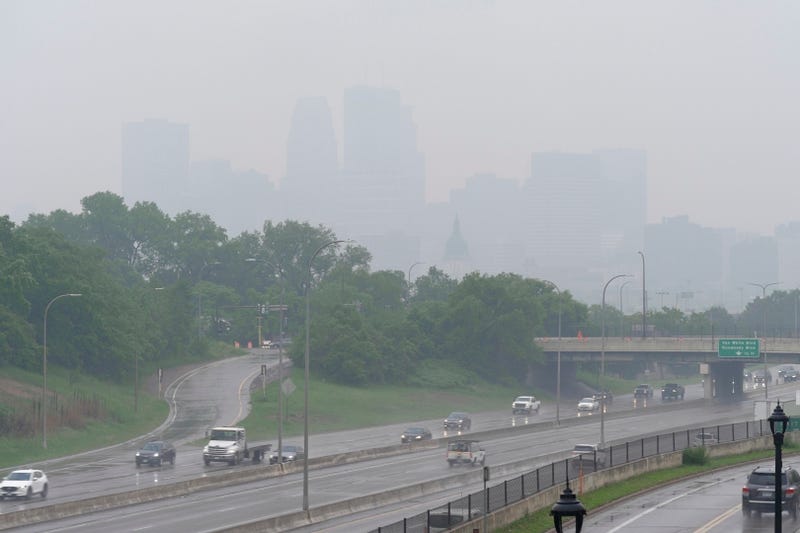Much of Minnesota will be getting a bit of a reprieve starting Wednesday morning from the smoke from the Canadian wildfires - but don't get used to it.
There are more than 200 active wildfires burning in Canada with half of them classified as "out of control." Officials in Canada say they can't just quickly get to these fires to try to put them out due to the remote nature of the areas.
Travis Verdegan is with the Minnesota Department of Natural Resources and the Minnesota Interagency Fire Center. He says they are complex fires and unpredictable.
"So, if a lightning strike, for instance, happens in the middle of a large wilderness area, just getting to the fire in the first place may be the first big challenge," Verdegan explains.
Is there any chance of being able to get ahead of the fires and get them under control?
"At this point, with the scale of the fires that they're dealing with, the most powerful force that would put the fire out would be Mother Nature herself," Vergedan ads.
The air quality alert for the Twin Cities ends at 12:00 p.m. Wednesday. That doesn't mean the entire region is free and clear. There is still an Air Quality Alert in parts of Minnesota, Wisconsin and Michigan which were rated “very unhealthy."
Verdegan says the Canadian wildfires are massive, burning with 3.7 million acres. He described what firefighters are up against.
"When all of the forces are in favor of the fire and not the firefighter, that's the type of situation you see that results in these fires getting this large," he says. "And the larger they get, actually the harder they are to even get any type of a handle on them."
Verdegan says it's not likely they will be put out until enough rain drenches those areas - which isn't likely to happen anytime soon.
The fires have forced more than 27,000 Canadians in three provinces to flee their homes, and the smoke has even reached Europe.

The smell of smoke hung over the Minneapolis-St. Paul area on Tuesday morning despite rain that obscured the full measure of the dirty air - air that was as bad as anywhere in the world and quite possibly the most hazardous the state has ever seen.
The Minnesota Pollution Control Agency issued an alert for almost the entire state into Wednesday, but the Twin Cities area got the worst of it in the Midwest on Tuesday.
Hospitals are seeing more patients with respiratory symptoms
Hennepin Healthcare, the main emergency hospital in Minneapolis, has seen a slight increase in visits by patients with respiratory symptoms aggravated by the dirty air.
Dr. Rachel Strykowski, a pulmonologist, said there is usually a bit of a delay before patients come in, which is unfortunate because the sooner those patients contact their doctors, the better the outcome. Typical symptoms, she said, include “increase in shortness of breath, wheezing, maybe coughing a bit more, and flares of their underlying disease, and that's usually COPD and asthma.”
What happens, Strykowski said, is that the fine particulate matter from the wildfire smoke triggers more inflammation in patients' airways, aggravating their underlying medical conditions.
Strykowski noted that this is usually a time those patients can go outside and enjoy the summer weather because there are fewer triggers, so the current ones forcing them to stay inside can feel “quite isolating."
People can protect themselves by staying indoors or by wearing N95 masks, she said. Strykowski added that they must be N95s because the cloth masks many people used during the COVID-19 pandemic don't provide enough filtration.
The Canadian fire situation
Canada is having another bad wildfire season, and more than 27,000 people in three provinces have been forced to evacuate. Most of the smoke reaching the American Midwest has been coming from fires northwest of the provincial capital of Winnipeg in Manitoba.
Winnipeg hotels opened Monday to evacuees. More than 17,000 Manitoba residents have been displaced since last week, including 5,000 residents of the community of Flin Flon, nearly 400 miles (645 kilometers) northwest of Winnipeg. In neighboring Saskatchewan, 2,500 residents of the town of La Ronge were ordered to flee Monday, on top of more than 8,000 in the province who had been evacuated earlier.
In Saskatoon, where the premiers of Canada’s provinces and the country’s prime minister met Monday, Saskatchewan Premier Scott Moe said all of Canada has come together to help the Prairie provinces.
Two people were killed by a wildfire in mid-May in Lac du Bonnet, northeast of Winnipeg.
Canada’s worst-ever wildfire season was in 2023. It choked much of North America with dangerous smoke for months.
The smoke reaches Europe
Canada’s wildfires are so large and intense that the smoke is even reaching Europe, where it is causing hazy skies but isn’t expected to affect surface-air quality, according the European climate service Copernicus.
The first high-altitude plume reached Greece and the eastern Mediterranean just over two weeks ago, with a much larger plume crossing the Atlantic within the past week and more expected in coming days, according to Copernicus.
“That’s really an indicator of how intense these fires are, that they can deliver smoke,” high enough that they can be carried so far on jet streams, said Mark Parrington, senior scientist at the service.
The fires also are putting out significant levels of carbon pollution — an estimated 56 megatonnes through Monday, second only to 2023, according to Copernicus.
The Associated Press contributed to this story.
